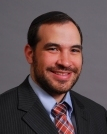Incredible shrinking opportunity
NCSY estimates 15 more years to reach Jewish high schoolers
By Michelle Bortnik
Issue of October 16 2009/ 29 Tishrei 5770Rabbi Aryeh Lightstone, regional director of New York NCSY, was speaking at a shul in the Five Towns last year when he recounted an incident in a student club he ran in an East Meadow public school. One girl was strikingly enthusiastic about everything the club discussed: Israel, Jewish continuity, holidays and Shabbos.But there was one catch: the girl wasn't Jewish.
When she inquired about becoming Jewish, Rabbi Lightstone told her that while she was welcome in the club, he couldn't teach her more about Judaism unless her parents gave explicit permission, something they expressly refused to do.
The girl was dejected and spent the following Christmas break with her maternal grandparents. Seeing she was unhappy, the girl's grandmother asked why. She wanted to learn more about Judaism, the girl said, but couldn't since she wasn't Jewish.
“You don't have to convert,” her grandmother explained, “I'm Jewish and so are you.”
Amid college fairs, SATs, football games and parties, high school presents kiruv (Jewish outreach) professionals what is perhaps their best opportunity to reach unaffiliated Jewish students, who otherwise might never be exposed to Torah Judaism.
“These kids are not in college so we know exactly where they are,” Rabbi Lightstone explained. “The only way to find them is in the public schools between the hours of eight and three-thirty. That's where 85% of our teens are.”
There are 35,000 Jewish teens in New York according to a Federation survey completed in 2001. Six or seven thousand are in various Yeshiva day schools and seven thousand are already in the NCSY database, but that leaves a troubling figure.
“We're still missing half the Jewish people,” Rabbi Lightstone said. “I am asked the question many times of whether going to public schools is a frill when there are Orthodox families needing help. It is our obligation to reach out to these kids.”
And he believes that mission is becoming more and important.
“Inside of each club, I am lucky if out of 50 kids, 15 kids have both Jewish parents. The other half either has just a Jewish mother or a Jewish father. 15 years from now [only] five kids will have both Jewish parents. Out of the other 35 only a quarter will have Jewish mothers,” Lightstone predicts. “If we don't find these kids now, in the next 15 years there will be no one to find.”
High school is also a most crucial time for kiruv efforts since it is the first time that individuals can truly begin to make their own decisions.
“I think the Torah is very clear that someone becomes an adult at age 12 or 13,” says Rabbi Steven Burg, international director for NCSY. “They start figuring out their place in the world and all the important issues in life. Judaism has to be there to make them realize it is relevant to everything they have to go through... These are the crucial years, it's a major pivotal time in a child's life; college is too late.”
“It's a tough age, many people don't understand it,” says Rabbi Burg. “People find high school kids sometimes stubborn but they don't realize that when they [high school kids] are stubborn outside it's masking their uncertainty of where they're headed.”
New York NCSY has a full-time staff of 15, plus 15 part-timers and 150 advisors. The organization offers weekly club meetings at local public schools, where students can come and schmooze for 25 to 40 minutes while enjoying free pizza. Offering clubs inside high schools is essential, Rabbi Lightstone explained, since most teens are most comfortable in a familiar environment.
NCSY also has a weekly 'latte and learning' sessions in a local Starbucks where students are able to talk more in depth about specific Jewish issues like free will and life after death. Once a month NCSY runs a program called 'Friday Night Lights,' where students can come enjoy a free Shabbat dinner and lunch.
Rabbi Lightstone became the regional director for Long Island NCSY in 2006. On his watch, three public school clubs grew to 18, and the organization went from having 100 kids at events to between 400 and 500; from sending two or three kids to Israel each year to sending close to 25. The Long Island region recently merged with the New York region to create one larger area that encompasses Long Island, Westchester, and the five boroughs of New York City. The decision to merge both regions, whose offices were twenty minutes apart, made both financial and practical sense to NCSY and to the Orthodox Union, the parent organization that provides most of the funding.
“We decided to merge in order to be more efficient in today's economy and more effective in terms of the outreach we could accomplish,” Rabbi Lightstone says. “We now have the ability to see instead of 700 or 800 kids, about 1,582 unique teenagers.”
The National Jewish Population Survey of 2000-2001 reported an overall Jewish population of 5.2 million in the United States. Of the 5.2 million, nearly 20% did not identify themselves as Jews and had no connection to any Jewish organization or synagogue. The survey also noted that the highest level of affiliation was among families with children of elementary school age.
Additional reporting contributed by Michael Orbach

 60.0°,
Mostly Cloudy
60.0°,
Mostly Cloudy 







